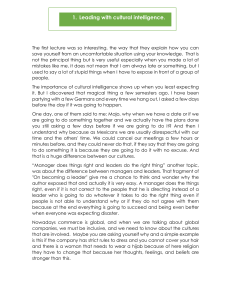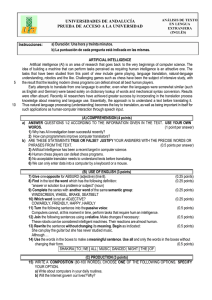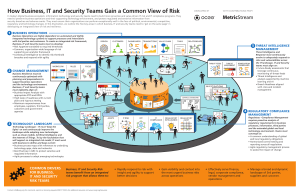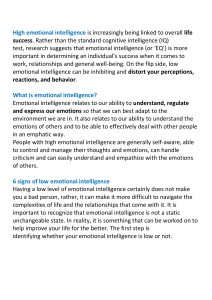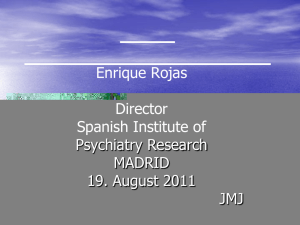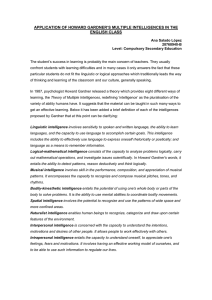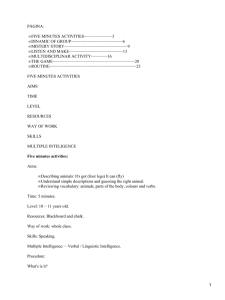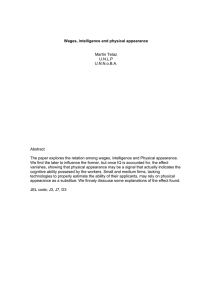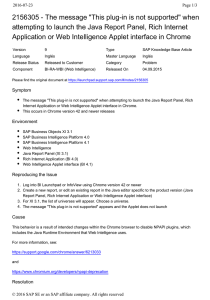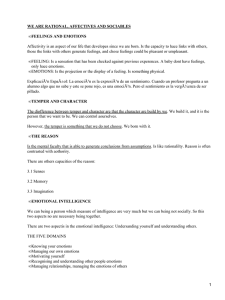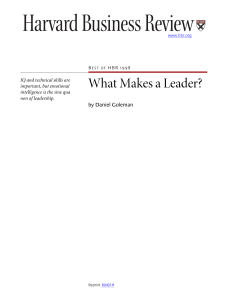Task 1 – Long Reading: Emotional Intelligence At a glance Procedure
Anuncio
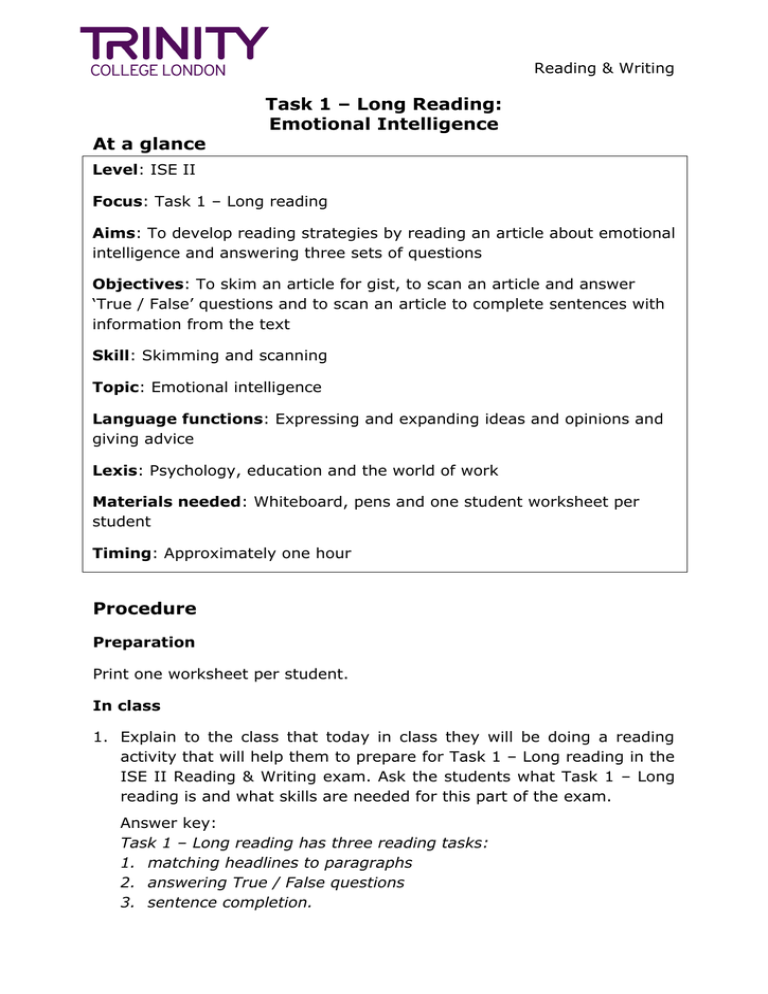
Reading & Writing Task 1 – Long Reading: Emotional Intelligence At a glance Level: ISE II Focus: Task 1 – Long reading Aims: To develop reading strategies by reading an article about emotional intelligence and answering three sets of questions Objectives: To skim an article for gist, to scan an article and answer ‘True / False’ questions and to scan an article to complete sentences with information from the text Skill: Skimming and scanning Topic: Emotional intelligence Language functions: Expressing and expanding ideas and opinions and giving advice Lexis: Psychology, education and the world of work Materials needed: Whiteboard, pens and one student worksheet per student Timing: Approximately one hour Procedure Preparation Print one worksheet per student. In class 1. Explain to the class that today in class they will be doing a reading activity that will help them to prepare for Task 1 – Long reading in the ISE II Reading & Writing exam. Ask the students what Task 1 – Long reading is and what skills are needed for this part of the exam. Answer key: Task 1 – Long reading has three reading tasks: 1. matching headlines to paragraphs 2. answering True / False questions 3. sentence completion. Reading & Writing The readings skills required are skimming (reading for gist) and scanning (reading for detail). 2. Write down IQ and EQ and elicit the meaning from the students. Answer key: Intelligence Quotient Emotional Quotient Ask students to work in pairs and write down as many different skills for each as they can think of. Carry out feedback as a group and write suggestions on the whiteboard. Suggested answers: IQ (memorisation, analysing texts, solving riddles, mathematics) EQ (understanding emotions, socialising, making people feel at ease, feeling at ease around people, providing a listening ear when people have problems, understanding when people have problems) 3. Now, ask the students to discuss in pairs which one they think is more important to become successful in life. Carry out feedback as a group. 4. Tell the students they are going to read about emotional intelligence. Give each student one student worksheet. Tell the students they need to carry out Task A. Ask them to read the text quickly and choose the best title for each paragraph. Tell them there is one more title than they need. Stop the students after two minutes and let them write down the answers. Then ask the students to compare their answers in pairs. 5. Go over the answer together as a class. Answer key: A3, B4, D1, E5, F2 6. Elicit from the students how they decided which heading was not possible. Ask students to carry out Task B. Tell them they should find different words for the following words and phrases in the headings: turning, in the workplace, cognitive intelligence, emotional intelligence, choosing the right people. Do the first one together as a class. Then ask them to first work alone and then compare answers in pairs. Carry out feedback as a group. Answer key: 1. turning (transforming) 2. in the workplace (at work) 3. cognitive intelligence (problem-solving, memory) 4. emotional intelligence (social and emotional abilities) Reading & Writing 5. choosing the right people (hiring competent trainers) 6. its true meaning (So, what does it really mean?) 7. Tell the students they are going to read the article again but now they have more time. Ask the students to do Task B. Tell the students that there are five statements and that they need to say whether each statement is True or False. Tell the students that it is a good idea to first look at the statements and underline key words. Then tell the students to find the answers in the text. After four to five minutes, ask the students to compare their answers in pairs. Ask five students to come to the whiteboard and tell them to each write down one answer. Answer key: 1. False 2. True 3. True 4. True 5. False 8. Go over the answers together as a class. Ask the students which words they underlined in each statement. 9. Tell the class they now need to complete Task C which involves them completing the sentences by looking for the information in the text. Do one example together as a class. Tell students that a possible strategy to use for this type of activity is to first predict what kinds of words they need to look for. Elicit from the student the kinds of words or phrases for each sentence. Answer key: 1. a verb 2. a noun 3. a verb 4. a discourse marker 5. a multi-word verb. Then tell them to find the answers in the text. Ask the students to compare answers once they have finished. Answer key: 1. resisted the temptation 2. buzz word 3. express 4. First and foremost 5. taken … on board. Go over the answers and put them up on the board. Reading & Writing 10. Ask students to find three new words or phrases in the text. Tell them for each word or phrase: to use it in a sentence, to give a synonym, to give an antonym, to translate it in their mother tongue. Ask students to put example sentences on the board and correct the sentences together as a class. Extension activity 1. Ask the stronger students to write one or two True / False questions for the text. They can then ask their partner the questions and feedback on their answers. 2. Write the following statements on the board: ”The idea behind constructive criticism makes sense but I often find that it is better to tell people in very clear terms what they are doing wrong.” “All this talking about emotional intelligence is too vague for me. It’s not real science.” “We’ve gone too soft. Just get on with the job.” Ask students to discuss in pairs whether they agree or disagree. Facilitate a class discussion afterwards. Further support activity 1. If students feel uncomfortable with reading activities, then don’t mention a time-limit when they are reading for gist. 2. Ask stronger students to check the answers of the weaker ones. After class Ask the students to look online for an EQ test and take the test. Ask the students to report back in the next class. Reading & Writing Student Worksheet Task 1 – Long Reading: Emotional Intelligence Read the text below and answer the questions. Emotional Intelligence 1. In a famous experiment, a group of four year-olds were left alone with candy and they were told that they could not eat any until the adult returned. Years later, when the children were grown-ups, the researchers did a follow-up to the experiment. It turned out that children who resisted the temptation became more successful later in life. Traditionally, psychologists described intelligence in terms of problem-solving and memory. This test shows the importance of another kind of intelligence, so-called emotional intelligence. IQ tests are only one way to see how successful someone may become in life. Social and emotional abilities seem even more important. 2. Emotional intelligence is a buzz word that is often heard. So, what does it really mean? The term ‘emotional intelligence’ was coined in 1990. Emotional intelligence has to do with knowing when to express emotions and knowing when to control them. Empathy is a particularly important part of emotional intelligence. This is basically the ability to recognise other people’s emotions. 3. It is necessary though to make a distinction between emotional intelligence and emotional competence. Let me illustrate this with an example. We already mentioned empathy as the ability to understand what someone else is feeling. Emotional competence would then mean transforming this into a skill. Empathy can actually be used to influence other people’s behavior. Obviously we are talking about influence in a positive manner as opposed to manipulation. 4. Emotional intelligence is important for a successful performance at work but how can it be promoted? First and foremost, the competencies that are important are different from job to job, so it is essential to know what these are for your field. Self-awareness is here the core competence to develop. So employees should learn how their feelings and behavior affect themselves and others. After that, look at the individual and try to find out if they have the necessary social skills for a particular job. Then, share this information with the individual and when doing so, try to be as clear as possible. Always conduct feedback in a constructive manner because then it is more likely to be taken on board. Another advantage of constructive criticism is that it minimizes defensiveness. 5. Hiring competent trainers is key. Good trainers have empathy and are genuinely caring. They should adopt a step-by-step approach because a change in behaviour is more likely to happen if it is manageable and achievable. Trainers should provide ongoing feedback and help develop the skill of self-reflection. If there is no follow-up training, then the whole process is likely not to be taken seriously. Reading & Writing A. Read the text quickly. Choose the best title for each paragraph from A-F below and write the letter in the box. There is one more title than you need. Titles A. Turning emotional intelligence into a skill Paragraph B. Emotional intelligence in the workplace C. Train the trainers D. Cognitive and emotional intelligence E. Choosing the right people F. Its true meaning B. What different words can be found for the following words and phrases in the headings? 1. turning: ………………………………………………………………………………………………..... 2. in the workplace: ………………………………………………………………………………………………..... 3. cognitive intelligence: ………………………………………………………………………………………............ 4. emotional intelligence: ………………………………………………………………………………………............ 5. choosing the right people: …………………………………………………………………………………................ 6. its true meaning: ……………………………………………………………………………………………….. Reading & Writing C. Read the text again. Are the statements True or False? Statements True or False? 1. There was no correlation between eating the candy and later achievements. 2. Part of emotional intelligence is being able to put yourself in someone else’s shoes. 3. We should distinguish influence from manipulation. 4. People may get hostile when talking about their job performance. 5. It is sufficient to give the employee information about their performance since it is their own responsibility to improve. D. Complete the sentences with information from the text. 1. I’m very proud of myself as last night ………………….…………………….… to smoke. 2. My manager likes using trendy words. Self-reflection seems to be his new ………………………………………..at the moment. 3. He is obviously not able to ………………………………………………………. his true feelings. 4. Drinking a lot of water is ………………………………………. if you want to survive. 5. He seems to have …………………my advice …….……….. as he is a lot more polite now. Reading & Writing Answer Key A. A3, B4, D1, E5, F2 B. 1. transforming 2. at work 3. problem-solving, memory 4. social and emotional abilities 5. hiring competent trainers 6. So, what does it really mean? C. 1. False 2. True 3. True 4. True 5. False D. 1. resisted the temptation 2. buzz word 3. express 4. essential 5. taken … on board Original source: http://www.eiconsortium.org

